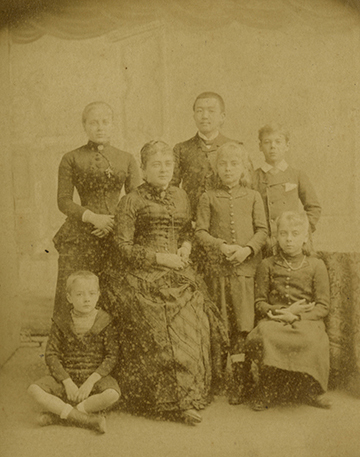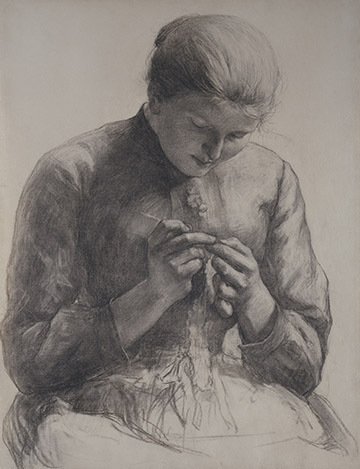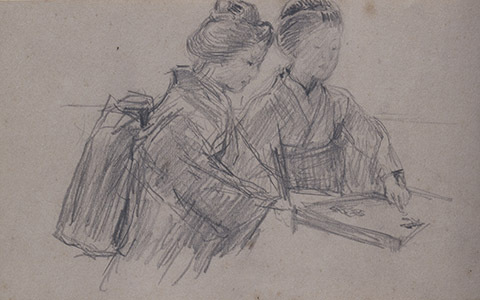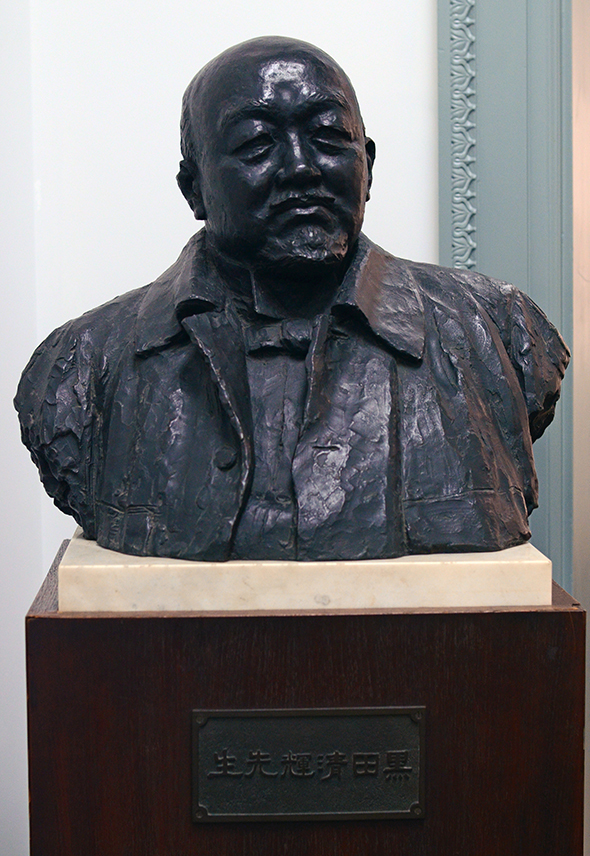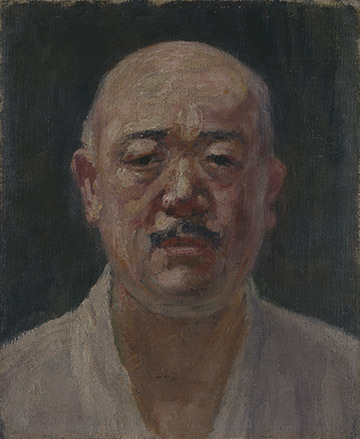About the special room
Q: Could you explain about the special room?
This hall was implemented the seismic reinforcement and reopened in 2015. On that occasion, this special room was newly set up for visitors to appreciate Kuroda's masterpieces.

About "Reading"
This painting was made when Kuroda stayed in France. It was accepted for the Salon in France. It is a memorable work for both Kuroda and Western-style painting circles in Japan. Kuroda lived in Grez-sur-Loing, a small village far away from Paris, and created paintings after studying painting under Raphael Collin. It depicts a young woman called Maria Billault whose family took care of Kuroda in Grez-sur-Loing. There is an anecdote that Maria and Kuroda were in love with each other. (continued in the lower column)



About "Maiko Girl"
Kuroda created this painting in Kyoto after returning home. Since he stayed in France for a long time, he painted Kyoto's customs as if a French man or stranger painted. A flavor of Japonism can be seen in the painting, which was popular in Europe at that time. Kuroda is now acclaimed in the Japanese art history that he introduced the very bright expression called "pleinairisme" into Japan. In this painting, it seems that paints are directly applied to the patterns of the kimono without mixing them. In contrast to former Western-style paintings in Japan, which adopted dark expression and was called "Yani-ha," or resin school, young painters, including Kuroda, was called "Murasaki-ha," or purple school, which adopted the Impressionist-like style and established the very bright and fresh style. Therefore, Kuroda moved into the limelight. (continued in the lower column)


The reason Kuroda eagerly brought the new Western art in the Japanese art circles was that he wanted to have nude paintings take root in Japan. The Western art has attached great importance to expressions of human bodies since the classical times. That tradition was also observed in the French art circles in the 19th century.
This painting "Wisdom, Impression, Sentiment" was created in order to introduce nude paintings in Japan. However, in Japan, there was no custom to appreciate a nude in a public place, so the painting stirred controversy. One magazine that carried the painting was discontinued. Although Kuroda's another nude painting was censored, and the lower part of the body in it was wrapped by a cloth, Kuroda continued his challenge without being discouraged by such criticism, thinking that nude paintings are the basics of art.
Q: Is the theme of this painting the three Graces?
Yes, it is. In addition, it is titled "Wisdom, Impression, Sentiment," a very abstract title, other than just a nude painting. I think he tried to add a sophisticated meaning to it other than just depicting a nude in the context of the Western art. Kuroda himself did not speak much about this painting, so it is not quite clear why he titled it "Wisdom, Impression, Sentiment." However, it can be said that this painting brought an expression technique that incorporated a nude and an abstract idea in the context of the Western art into Japan.
Q: What is the material of this painting?
It is the oil painting. Gold was applied to its background, but most of it has now come off.
Q: Has gold foil come off? I think the painting looked more gorgeous at that time.
Gold foil or pigment was applied to it. Some parts of the painting come off significantly, so it is not clear what was actually applied. However, when seeing a color photograph shot around 1960s, it becomes clear that the entire background was golden-colored. It can be thought that Japanese traditional expressions, such as gold foil and gilded folding screen, were incorporated into this painting, so it looked more dazzling when it was created.
On the other hand, some Western painters, including Gustav Klimt, used gold foil in their paintings. Some academic painters in the previous generation also used gold foil, so it is not clear whether this kind of expression originated in the West or the East. There is a possibility that the West and the East had influenced each other.
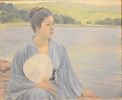
About "Lakeside"
This is the most famous painting Kuroda created. This painting often appears in school textbooks. As I mentioned before, Kuroda had an ambition to bring the main stream expression of the Western art into Japan. The expression of a group that combines multiple figures is also the tradition of the Western art. Although Kuroda also tried to bring that expression into Japan, after all the most widely spread and popular expression that Kuroda created was clear and bright expression that was the latest one at that time in France.
A portrait of a woman that reminds us of ukiyo-e in the Edo Period is depicted in this painting. The woman is Teruko who later became a wife of Kuroda. I think its clear and fresh expression appealed to tastes of Japanese. Successors of Kuroda also tried to reproduce such expression. (continued in the right column)
Q: It looks like a watercolor painting. Were those thinly layered paintings like watercolor paintings popular at that time?
I think that pale expression like a watercolor painting matched Japanese tastes. Watercolor paintings became popular after this painting was open to the public. It can be said that this oil painting with the pale expression like a watercolor painting led the fashion at that time.
Q: Did Kuroda make many watercolor paintings?
He did not make many watercolor paintings. Most of his paintings are oil paintings. However, when watercolor paintings and picture postcards came into vogue later, he made some watercolor paintings.
Q: Do you routinely change exhibits in the special room?
The exhibits are not changed. The memorial room is always open to the public, but the special room is not. The special room is open to the public for about two weeks three times a year in the New Year holidays, spring and autumn.
About the bust of Seiki Kuroda
This bronze statue was created by Kotaro Takamura (1883-1956) after the death of Kuroda. Takamura, who is also famous as a poet, graduated from the Department of Sculpture, Tokyo Fine Arts School. Kuroda was revered as a prominent professor at Tokyo Fine Arts School. Takamura was commissioned to create this sculpture after the art institute was founded. Takamura highly respected Kuroda, and this sculpture is one of his masterpieces. (continued in the lower column)
There is an inscription with a Chinese character "Hikari," which means "Ko" for "Kotaro," on the right side of the chest.

About the exterior of the building that is a national tangible cultural asset
Q: Was the exterior of the building renewed?
It was renewed with reproductions of tiles that were popular at that time. Another masterpieces of Shinichiro Okada who designed this building was the Tokyo Prefectural Museum. Unfortunately, the museum was demolished in 1975, and the new museum designed by Kunio Maekawa was built.
Q: The former Tokyo Prefectural Museum was a Western-style stone-built building, wasn't it?
Columns that looked like those of Greek temples stood in a row at the front entrance. It was an architectural style established by Shinichiro Okada who had a profound knowledge of the Western architecture.
About the relationship with Tenshin Okakura
Since Kuroda tried to spread the Western art and its concept in Japan, I think that he had friendly rivalry against Okakura. Traditional Japanese arts, such as Japanese painting and industrial arts, were mainly taught at Tokyo Fine Arts School, and there was no Western painting course until Kuroda became an instructor at the school. I think, although Okakura planned to expand the school and its departments, it was beyond his expectation that Kuroda began to teach a Western painting course at the school.
About Kuroda's career
Q: Kuroda later became a member of the House of Peers, didn't he?
Kuroda's foster father was also a member of the House of Peers, so Kuroda succeeded to the position. Kuroda came from Satsuma Province, and had plenty of contacts. He had a social connection with then Education Minister Kinmochi Saionji, so he could be an instructor at Tokyo Fine Arts School.
About Kuroda's style and paintings
Q: Did Kuroda switch between Western-style and Japanese-style paintings according to motifs? Did he know paintings of Claude Monet?
Although Kuroda studied under Raphael Collin who kept a distance from the Impressionism, Kuroda's brush strokes are rougher than those of Collin, and his way of using paints, that is, using paints without mixing them, is suggestive of the Impressionism.
Q: Are Kuroda's paintings left in Tokyo University of the Arts (former Tokyo Fine Arts School)?
There are some paintings. The most famous one is "Kitchen" that was created when he stayed in France. That painting depicts a women called Maria Billault who is also the model for "Reading." It was not accepted for the Salon, but can compare favorably with "Reading." (continued in the lower column)
This painting was originally titled "Le Lever," and accepted for the Salon of the Societé Nationale des Beaux Arts. It was also displayed at the 6th Meiji Bijutsu-kai Exhibition (1894) and the 4th National Industrial Exhibition (1895), and awarded prizes, but stirred up controversy that the nude painting had a harmful effect on public morals. Georges Ferdinand Bigot (1860-1927), a French cartoonist, depicted the fuss in a cartoon in which Japanese people stared in wonder at the painting.

About the opening days of Kuroda Memorial Hall
Miyao: The hall opened just two days a week before the renewal, but now its opening days are the same as those of Tokyo National Museum. Exhibits in the memorial room are changed every one and a half months.
Q: The adjacent coffee shop was also renovated. Have visitors to the hall increased?
It seems that many people come to the coffee shop. Such a shop does not exist around this area, so it is convenient for them. There are also Tokyo National Museum, Tokyo Metropolitan Art Museum, and the University Art Museum, Tokyo University of the Arts in the neighborhood, so visitors to those museums walk into the coffee shop.









